November 21, 2008
Air Date: November 21, 2008
FULL SHOW
SEGMENTS
Obama’s Pledge
/ Ashley AhearnView the page for this story
President-elect Barack Obama says when he takes office the United States will take strong action to combat climate change. His videotaped remarks received a standing ovation at the Governors’ Global Climate Summit in Los Angeles and, as Living on Earth’s Ashley Ahearn reports, international leaders, legislators, and environmentalists praised Obama for his promise to make the U.S. a global warming leader. (06:00)
The Center at the Center of it All
/ Jeff YoungView the page for this story
Personnel from the Washington think tank Center for American Progress are now key players in the Obama transition team. And that’s a sign that climate change and clean energy will be high on the agenda for the new administration’s staff and cabinet. Living on Earth’s Jeff Young takes us inside the Center at the center of Obama's team. (06:00)
Fire Retardants Stoke Controversy
View the page for this story
The wildfires in California have been contained, but controversy over the use of fire retardants continues to blaze. Host Bruce Gellerman talks with Andy Stahl of the Forest Service Employees for Environmental Ethics and Tom Harbour from the U.S. Forest Service about the effectiveness and possible environmental effects of flame retardant. (06:10)
Down on the (Organic) Fish Farm
View the page for this story
The National Organics Standards Board is recommending the USDA allow farmed fish to be labeled “organic.” These “organic” fish could be fed up to 25 percent non-organic fish feed, and could also be kept in open ocean pens despite ongoing concern this can impact the wild fish supply and the marine ecosystem. Patty Lovera of Food and Water Watch tells host Bruce Gellerman these recommendations dilute organics standards. (06:30)
Tradition Revived
/ Bobby BascombView the page for this story
Almost all of the turkeys eaten in the United States are the same species: the Broad-Breasted White. But as Living on Earth’s Bobby Bascomb reports, heritage breeds of turkeys, like the Bourbon Red and Blue Slate, are making a comeback. (04:03)
Wal-Mart’s Wishes
View the page for this story
The world’s largest retailer says it won’t do business with suppliers who violate environmental laws. But can Wal-Mart's low-cost mission align with its lofty goals for sustainability? Host Bruce Gellerman talks with green business consultant Andrew Winston about how Wal-Mart can clean up its act while cleaning up the environment. (06:30)
Green Hospitals
View the page for this story
Critics say hospital buildings and food are enough to make you sick. Today there's a growing movement in health care to get hospitals to green their facilities and, as host Bruce Gellerman reports, it's transforming the medical community. (08:00)
This week's EarthEar selection
listen /
download
Carion crows call through the woods in Woodchester Park in Gloucestershire, England.
Show Credits and Funders
Show Transcript
Host: Bruce Gellerman
Guests: Tom Harbor, Andy Stahl, Andrew Winston
Reporters: Ashley Ahearn, Bobby Bascomb, Bruce Gellerman, Jeff Young
[THEME]
GELLERMAN: From Public Radio International, this is Living on Earth.
[THEME]
GELLERMAN: I’m Bruce Gellerman.
The winds of change blow as president elect Barack Obama pledges to act on climate change.
OBAMA: When I’m president, any governor who’s willing to promote clean energy will have a partner in the White House, and any nation that’s willing to join the cause of combating climate change will have an ally in the United States of America.
GELLERMAN: Also, Obama’s transition team taps a liberal think tank to help fill pivotal positions in the new administration.
And U.S. hospitals undergo major surgery to green up their act.
COHEN: If you’re getting your IV drip with a PVC medical device it is dripping a reproductive toxin into your veins. Nobody’s telling you that, but that’s the facts.
GELLERMAN: Hospitals once enough to make you sick are on the mend. We take the pulse of the green medical movement.
These stories and more, this week on Living on Earth. It’s radio that’s good for what ails you.
ANNOUNCER: Support for Living on Earth comes from the National Science Foundation and Stonyfield Farm.
Obama’s Pledge
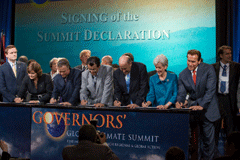
California Governor Arnold Schwarzenegger (far right) and other governors sign the Governor’s Global Climate Summit declaration. (Courtesy of the Office of the Governor)
[THEME]
GELLERMAN: From the Jennifer and Ted Stanley studios in Somerville, Massachusetts, This is Living on Earth. I’m Bruce Gellerman, in for Steve Curwood.
Change was the watchword during the presidential campaign and now that it’s over, the winds of change are definitely blowing in Washington. As we reported last week, a storm was brewing among democrats over the chairmanship of the powerful House Energy and Commerce committee. California representative Henry Waxman was challenging Michigan’s John Dingell, who held the job for 28 years.
Representative Dingell, a stalwart supporter of the auto industry, had been a long time opponent of stiffer fuel economy standards. Congressman Waxman is a longtime champion of environmental causes. When the results were counted, Waxman won by 15 votes, delighting many environmentalists. Senator Barbara Boxer:
BOXER: I think Congressman Waxman will be a great chairman, but for me as a Californian, I’ve watched Henry over the years. I could not frankly have a better partner as we head into these days and I think it just signals the change, the sea change. It’s momentous. The problems are momentous as well.
GELLERMAN: When Congressman Waxman takes up his new chairmanship, he’ll find he has a strong supporter in the White House – especially when it comes to climate change. This past week, President-elect Barack Obama laid out his plans to deal with global warming – a departure in substance and tone from the Bush administration. Living on Earth’s Ashley Ahearn reports.
AHEARN: He’s still two months away from taking office, but Barack Obama is tackling the issue of climate change head on. Here he is in a video-taped address to the bipartisan governors’ climate conference in Los Angeles.
OBAMA: Few challenges facing America and the world are more urgent than combating climate change. The science is beyond dispute and the facts are clear. Sea levels are rising, coastlines are shrinking; we’ve seen record drought, spreading famine, and storms that are growing stronger with each passing hurricane season. Climate change and our dependence on foreign oil, if left unaddressed, will continue to weaken our economy and threaten our national security.
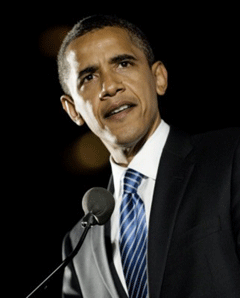
President-elect Barack Obama. (Courtesy of Barack Obama)
SCHWARZENEGGER: America has been the biggest polluter of any country in the world, up until recently. And we have the big responsibility, and as a country, we have not taken on that responsibility. Washington has not taken on the responsibility of having an energy policy or an environmental policy. And this is why I was so enthusiastic to listen to the message of President-elect Obama. To say that he wants to adopt the same regulations we have.
AHEARN: The president-elect says fighting climate change means building a green economy that will create five million new green jobs in the U.S., lessening the nation’s dependence on foreign oil and strengthening national security. Obama also plans to set limits on CO2 emissions.
OBAMA: That will start with a federal cap and trade system. We’ll establish strong annual targets that set us on a course to reduce emissions to their 1990 levels by 2020 and reduce them an additional 80 percent by 2050. Further, we’ll invest 15 billion a year to catalyze private sector efforts to build a clean energy future. We’ll invest in solar power, wind power and next generation biofuels; we’ll tap nuclear power while making sure it’s safe, and we will develop clean coal technologies.
AHEARN: These remarks indicate that the president-elect plans to make good on the climate change and energy promises he made during the campaign. The renewed pledge drew tentative praise from Nick Berning of Friends of the Earth.

California Governor Arnold Schwarzenegger (far right) and other governors sign the Governor’s Global Climate Summit declaration. (Courtesy of the Office of the Governor)
BERNING: On balance it’s a very strong plan – he’s signaling real leadership, he’s signaling that he’s prioritizing this issue, and that he’s going to work to help us win the fight against global warming. That said, there are a number of details here that we’re encouraging Obama to rethink. First, we’re calling for a greater reduction in emission by 2020. We also applaud Obama’s focus on clean energy and energy efficiency, and we’re hoping he’ll keep the focus on those and de-emphasize some of the other things he’s talked about, including nuclear power and coal.
AHEARN: The president elect wasn’t specific on how he would make nuclear power safer, or coal cleaner, but he did say he would vigorously engage in international negotiations and “lead the world toward a new era of global cooperation on climate change.”
OBAMA: Stopping climate change won’t be easy and it won’t happen overnight, but I promise you this: when I am president, any governor who’s willing to promote clean energy will have a partner in the White House. Any company that’s willing to invest in clean energy will have an ally in Washington, and any nation that’s willing to join the cause of combating climate change will have ally in the United States of America.
AHEARN: Obama’s speech before the nation’s governors sets the stage for upcoming climate talks in Poland next month. Fuchan Yang, vice-president of Beijing-based Energy Foundation, says Obama’s commitment to cut U.S. greenhouse gas emissions is a challenge China will have to meet.
YANG: Now the wind change – the new administration will make change – also this change is not only for U.S. but also in China. So here China will exceed U.S. very soon become number one emitters. So when U.S. joins the international community for the commitment, China have to do something.
AHEARN: India also faces that challenge – the rapidly developing nation is a major emitter of greenhouse gases. Arvind Kumar, of the Indian Forest Service, attended the Governors’ conference in California. He heard Barack Obama’s speech.
KUMAR: He was full of confidence and conviction as far as tackling this great global climate issue is concerned. The USA is the number one country in the world and the president elect of that country, if he’s confident we’re going to tackle it, I think the world will tackle it. All countries will support, irrespective of caste, color, region or politics. It’s a great issue because in this particular crisis, either all of us will remain or all of us will perish.
AHEARN: President-elect Obama will not be attending the climate change summit next month in Poland, but he’s requested a full report from U.S. lawmakers who will be attending.
For Living on Earth, I’m Ashley Ahearn.
The Center at the Center of it All
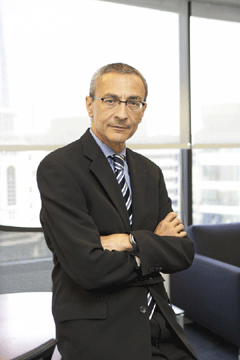
John Podesta. (Courtesy of the Center for American Progress)
GELLERMAN: Barack Obama’s position on climate change is also evident in the people he picked for his transition team. Several key members of the team have ties to a Washington, D.C. think tank called The Center for American Progress, or CAP. John Podesta, co-chair of Obama’s transition team, founded CAP, where he put climate change and clean energy at the forefront of its agenda. Living on Earth’s Jeff Young takes us inside the Center for American Progress.
YOUNG: In the long years that conservatives ruled Washington, liberals watched right-leaning think tanks like the Heritage Foundation with envy. Heritage dominated the national political agenda with new ideas and catchy talking points. Liberals had little to match it. So former Clinton Administration Chief of Staff John Podesta started the Center for American Progress to help progressives get their mojo back. CAP senior fellow Bracken Hendricks says Podesta essentially stole a page from the conservative’s playbook.
HENDRICKS: It’s much more similar to strategy that the conservatives and the right wing have used for a very long time. We are focused not only on good ideas, but on communicating those ideas.
YOUNG: With funding from financier George Soros and real estate billionaires Herb and Marion Sandler, CAP started small in 2003. Now its 180 employees and fellows run a sophisticated communications operation from a 10th-floor suite in downtown D.C. They turn out studies on the economy and national security that frame progressive ideas in positive terms of growth and strength. Hendricks focuses on energy and global warming, issues which were quickly integrated into CAP’s larger message. Instead of fighting the old economy-versus-environment battle, Hendricks says CAP emphasizes the potential to benefit both.
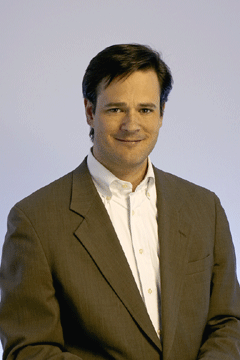
Bracken Hendricks. (Courtesy of the Center for American Progress)
YOUNG: A CAP study argues that clean energy investment can generate green jobs and stimulate the economy. It shows a 100 billion dollar investment would yield two million jobs, reduce greenhouse gases and keep wealth in the country rather than losing it to oil-rich nations.
HENDRICKS: The green sector – the energy sector, this investment in physical infrastructure that’s been so neglected - it turns out is a tremendous place to start priming the pump of the American economy, and, importantly it moves us in the direction we need to go.
YOUNG: The study gained traction with lawmakers who are crafting a new economic stimulus package. CAP founder Podesta emphasized green stimulus in his testimony this year before a Congressional committee on global warming.
PODESTA: The challenge I think we face as a nation and as a world is nothing short of conversion of our economy from high carbon energy, putting our national security and planet health at risk, to one based on low carbon sustainable sources of energy. The scale of that undertaking is immense but its potential is also enormous. I think the jobs of the future are clearly on the clean energy side.
YOUNG: Now Podesta takes that message to one of the most influential positions in Washington. President-elect barrack Obama picked Podesta to lead his transition, overseeing selection of the people who will fill the Obama cabinet and staff the White House. Several other CAP fellows are also on the transition team. Former EPA official Bob Sussman will help select the next administrator of the Environmental Protection Agency. Former Clinton Administration climate policy director Todd Stern will help organize the new White House team. Among his ideas: a new White House energy council to emphasize clean energy.

John Podesta.(Courtesy of the Center for American Progress)
Academics who think about think tanks say that’s an impressive list. City College of New York political science professor Andrew Rich wrote a book called “Think Tanks, Public Policy and the Politics of Expertise.”
RICH: Beyond the people, what about the ideas? Will the ideas that CAP has been talking about for the past few years, will they get a serious hearing in the new administration? I think there’s reason to be optimistic that they will be, but we’ll have to wait and see.
YOUNG: Rich says a 650-page book CAP released shortly after the election, “A Progressive Blueprint for the 44th President,” shows the group is eager to help shape the new administration. But CAP action fund spokesperson Daniella Gibbs Leger plays down
the center’s influence.
GIBBS LEGER: Well, I should clarify that there is no official link between the work that CAP does and the Obama transition.
YOUNG: I read in some political blogs and whatnot, and when there is a reference to CAP it will be followed by a phrase like, “the shadow government,” “the government in waiting.” What do you make of that?
GIBBS LEGER: Well that is often what we’ve been called for the past couple of years. Progressives have been out of power for a while. So, it remains to be seen how many of our ideas will be implemented by the new administration but we’ll definitely - gonna be pushing them to do so.
YOUNG: Gibbs Leger is coy about CAP’s newfound prominence. But there is one victory she’s not too shy to brag about. On the center’s reception desk stands a huge trophy. CAP won the think tank softball league championship – yes, such a thing exists in Washington. And they won it by defeating their ideological nemesis, the conservative Heritage Foundation.
GIBBS LEGER: Yeah, we ran with that! [Laughs] That’s a very good symbol.
YOUNG: For Living on Earth, I’m Jeff Young in Washington.
Related links:
- Who’s leading the Obama transition on environment
- Center for American Progress ideas on a “green” economic stimulus
- “Progressive Blueprint” for the new president
[MUSIC: David Byrne & Brian Eno, “Strange Overtones” from Everything That Happens Will Happen Today (Todomundo Records 2008)]
GELLERMAN: Just ahead, critics say the new standards for organic fish are floundering. Keep listening to Living on Earth!
Fire Retardants Stoke Controversy

A red line of fire retardant creates a barrier for slow moving wildfires in Nogales, Arizona. (Photo: Dyan Bone)
GELLERMAN: It’s Living on Earth, I’m Bruce Gellerman. Fueled by bone-dry weather and whipped up by the Santa Ana Winds, the recent wildfires in Southern California turned 70 square miles of land to a crisp. No deaths have been reported, but more 10,000 residents were evacuated and nearly a thousand homes destroyed.
To help save property and contain the wild fires thousands of gallons of fire retarding chemicals were dropped from aircraft. But as the fires die down, the controversy over the use - and some say abuse - of fire retardants is intensifying. Andy Stahl is executive director of Forest Service Employees for Environmental Ethics.
STAHL: Well we certainly are in favor of using them more prudently. They are fertilizer, ammonium phosphate and diammonium phosphate, and if dumped in streams they are highly toxic to fish. It’s as if a farmer took a slurry of liquefied fertilizer that he was going to spray on his field and instead dumped 3,000 gallons into the stream. And that fertilizer kills fish for miles downstream. One of the more infamous drops killed 20,000 fish in Fall River near Bend, Oregon several years ago.
GELLERMAN: There’s an awful large amount of fire retardant chemicals being used, 20,000,000 gallons plus a year?
STAHL: Yes and in a high fire year as much as 40,000,000 gallons dropped from these bombers. And it is a significant financial challenge for the Forest Service because this is not cheap stuff, thousands of dollars per drop. And it’s often used for what we call political firefighting, to put on a good show for the public, but doesn’t do anything effectively in fighting the fire.

A red line of fire retardant creates a barrier for slow moving wildfires in
Nogales, Arizona. (Photo: )
GELLERMAN: Well, does the stuff work?
STAHL: The stuff works in limited applications. The retardant doesn’t put out fires. It was never designed to fight fires in residential areas. What it was designed to do is to prevent small fires from getting larger as they creep along the forest floor. And it’s pretty good at that. What it’s completely worthless at is stopping a wind-driven firestorm such as we saw in southern California in the last several days. There, the wind blows embers and burning branches for up to half a mile. The fire retardant line is only several tens of feet wide. And so in a wind-driven firestorm retardant is worthless.
GELLERMAN: Well what would you do in the case of the Santa Ana fires? I mean, we can’t just let these things blaze to the coast, can you?
STAHL: There’s also not a heck of a lot you can do to prevent it. Notice in the news what you hear is firefighters gain an advantage on fire when the wind drops, when it rains. But when the winds are blowing 70 miles an hour and the humidity is three percent, there’s nothing firefighters can do. Period.
GELLERMAN: Well if your house were in the line of a wind driven wildfire, wouldn’t you want the firefighters to use something?
STAHL: Well if my house was in the line of a wind-driven fire, I would want to make sure my house was built properly. That’s the only secure way of insuring that my house won’t burn. If it has a fire resistant roof, fire resistant siding and if the vegetation is cleared out about a hundred feet from the house, then I’ll be quite confident that my house will survive a wildfire.
GELLERMAN: Your organization is now suing the U.S. Forest Service over the use of fire retardant chemicals. What’s the suit about and what are you looking for?

A plane drops fire retardant from the smoke-filled sky. (Courtesy of Fish and Wildlife Service)
STAHL: We want to force the Forest Service to disclose the real environmental costs and benefits of firefighting. Our lawsuit is a means to change the way our society approaches fire. We have to learn how to live with fire rather than fight a war against it.
GELLERMAN: Well, Mr. Stahl, thanks, I really appreciate it.
STAHL: My pleasure.
GELLERMAN: Andy Stall is executive director of Forest Service Employees for Environmental Ethics. It’s based in Eugene, Oregon.
Now joining me on the line is Tom Harbour. He’s the national director for Fire and Aviation Management for the U.S. Forest Service. And Mr. Harbour, thank you very much.
HARBOUR: Glad to be with you, Bruce.
GELLERMAN: To hear Mr. Stahl tell it, the Forest Service is poisoning our landscape in order to save it.
HARBOUR: We believe we’re putting another tool in the toolbox of our professional wildland firefighters for them to use when they deem it necessary.
GELLERMAN: Well what is appropriate in terms of these - I mean, when would you want to use a fire retardant? What kind of fire?
HARBOUR: We use retardant to help us lower the intensity of a fire that we can get in closer to, then, with those boots on the ground. We’ve seen retardant used effectively around communities under the proper conditions of not too much wind when these aircraft can be flying.
GELLERMAN: You know, Andy Stahl says that these chemicals weren’t intended to be used near, you know, communities. He also charges that they’re just PR drops, you know, just done for the benefit of showing the public that the Forest Service is doing something, even if it doesn’t work.
HARBOUR: As the leader of the wildland fire folks and the Forest Service, I’ll tell you that fire retardants can help with the ebb and flow of fire as they move. Fire retardants are especially effective because once the water evaporates from the mix they still have fire retardant qualities. We’ve used these chemicals safely for forty years and I hope we get to use them forty years into the future. We’ve got a good tool here.
GELLERMAN: Tom Harbour is the national director for Fire and Aviation Management for the U.S. Forest Service.
Mr. Harbour, thank you very much.
HARBOUR: Thank you, Bruce.
Related links:
- US Forest Service Office of Fire and Aviation Management
- Forest Service Employees for Environmental Ethics
- California Department of Forestry and Environmental Protection
[MUSIC: Thievery Corporation “Retaliation Suite” from Radio Retaliation (ESL Music 2008)]
Down on the (Organic) Fish Farm
GELLERMAN: The production of organic food is heavily regulated. Farmers who want to label their food organic can’t use pesticides, hormones, or artificial fertilizers, and they must feed livestock an organic diet. It’s a big business, and growing, but until now there was no such thing as an organic fish; organic beef, broccoli, and butter yes, but organic fish - no.
However, that could soon change. The National Organic Standards Board - which advises the USDA in these matters – has voted in favor of creating standards so fish farmers can also go organic. Joining me to talk about the vote is Patty Lovera, she’s assistant director of Food and Water Watch, a non-profit consumer group based in Washington D.C. Hi Ms. Lovera.
LOVERA: Thanks for having me.
GELLERMAN: Now the advisory group to the USDA has decided that farm-raised fish can be called organic or at least some can. Which farm-raised fish can be called organic?
LOVERA: So what the national organic standards board did was set out a recommendation to the USDA, and the USDA now has to write the rules for how you would certify farmed fish as organic. And there were a couple controversial pieces in that recommendation they made. And they said that farm-raised fish that are raised in something called open net pens, which are, you know, open to the environment, they’re often done out in the open ocean – that those could be possibly organic and that fish that were fed up to 25 percent wild fish in their diet could be certified as organic. And those are both very controversial decisions because we think they – our group and lots of other groups – thinks that it contradicts the real basic principles of organic production.
GELLERMAN: They can use 25 percent of wild fish in the organic fishes’ feed. Now a fish like tilapia could be raised on grain. So you could feed it 100% organic grain and call it organic, I guess, under this ruling. But salmon eat other fish, so if a salmon eats a wild fish and that wild fish is not organic, the farm-raised salmon is still considered organic?
LOVERA: Right. We believe you can’t really certify something as organic if you’re not in control of its production. I mean one of the core principles of organic is that you’re controlling the inputs and the outputs from that system, and so how do you certify something that’s wild. Um, that gets hard to do if you don’t know what it was eating, you don’t know how it was – you know, how it grew up. So, that’s been a controversial piece and there’s still unresolved issues there within organic. But what we do know is that other livestock, other organic animals that become food, they’re supposed to eat 100 percent organic feed and this is a really gaping loophole to set an exemption so high at 25 percent to let, you know, let this industry off the hook that other industries have to meet. There was another approach that the NOSB could have taken. They could have started with the stuff that’s a lot more compatible with organic production methods and those are vegetarian fish in closed system where you don’t have a lot of water flowing in and out and the possible pollution that comes from that. They chose not to do that. They chose to go for kinda the whole enchilada and deal with the whole aquaculture industry and give them a way into organic, and we think that’s just overreaching and it just misses the point of the fact that they’re supposed to set standards, not just open the door for anybody that wants to come get this label.
GELLERMAN: Well let’s talk about the pens vote - that is they voted overwhelmingly - ten to four – to allow organic raised fish to be raised in the open pens. So what’s the problem there?
LOVERA: Well, we have a concern with anybody using these open net pens in the open ocean. I mean, we’ve been very active trying to stop the promotion of this with any label on it, let alone organic. It’s a very controversial method. You know, we know that the fish escape and so if you have different species, you know, breeding with the wild fish that can damage their genetics. We know that the pollution caused by confining that many fish together flows out of these pens and can pollute the surrounding environment. You know, we know there’s so many risks with doing this type of production anywhere, and then to call it organic, it’s just really disturbing. The board did try to put some strings on it. They said oh, you know, be careful where you site it. You know, don’t put this kind of fish in this kind of environment because of the escape possibility. But none of the strings they put on it are enough.
GELLERMAN: To your way of thinking, then, can there be an organic fish or is that an oxymoron?
LOVERA: We think that you could come up with a way to have organic farmed fish that was compatible with organic standards if you start at an appropriate level, which is like we talked about with the vegetarian fish. You can do it in a closed system. There’s, you know, ways you can do it if you keep those principles at the center of it. But when you start branching out to these carnivorous fish, to these systems that are out in the open ocean or out in bodies of water, that’s when you kind of lose it on organic.
GELLERMAN: Well who has been advocating this? Who benefits from this decision?
LOVERA: I mean there is an aquaculture industry, you know, globally, that wants in on the organic market. I mean, they see the growth in organic, they see consumers’ response to it and they’re looking for that label, that stamp of approval. And there’s been more coverage of the environmental damage of a lot of types of aquaculture and I think that they’re looking for something to kinda deal with that stigma and say “No, we’re really – look at us, we’re good, we’re organic.” And so at every meeting there’s a bunch of us saying don’t do it and there’s also a bunch of companies saying, “Come on, come on, let us in. We can do it. We can do it. We’re good. Check us out. We’re environmentally safe.” And it’s, you know, it’s a real show usually during the public comment period from both sides.
GELLERMAN: You know, Ms. Lovera, organic farming has had positive effects on land use and it’s been good for people to eat. Would it be good to introduce that kind of farming to our oceans?
LOVERA: That was a really popular comment from the members of the board during the discussion about this issue. And it’s kind of an enticing argument, it can kind of suck you in. But our response to that is that the job of the National Organic Standards Board and the integrity of organic depends on really holding fast to a set of organic principles which are, animals eat organic feed, you minimize environmental impact, you promote biodiversity. Not that you just do slightly better than your competitors who are conventional. I mean, it’s had the impact of cleaning up practices because the industry’s had to reach a standard to get that seal.
GELLERMAN: Well I want to thank you very much, Ms. Lovera.
LOVERA: Alright, thanks.
GELLERMAN: Patty Lovera is Assistant Director of Food and Water Watch. We were also scheduled to speak with Dr. Hubert Karreman - the chairman of the advisory board to the USDA’s Organic program – but unfortunately Dr. Karreman had to cancel our interview at the last minute.
Related links:
- Food and Water Watch on Organic Aquaculture
- The National Organic Standards Board
- Read the National Organic Standards Board's recommendations for Organic Aquaculture here
- And here
[MUSIC: Joe Pipik "Turkey Blues" from 'Give Up the Gobble' (Self released—1983)]
Tradition Revived
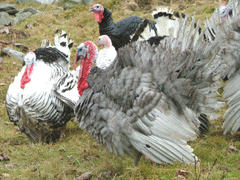
A Blue Slate tom turkey struts his stuff. (Photo: Marc Renaghan)
GELLERMAN: Around this time of year the turkey reluctantly takes its place of honor on dinner tables across the nation. Just trot down to your local store and you’ll find that 99 percent of the birds ready for roasting are the same breed: the broad-breasted white.
That’s certainly not the kind the pilgrims may have feasted on that first Thanksgiving so long ago. But today, ancient varieties of turkey are making a comeback. People are increasingly flocking to the old turkey taste, as Living on Earth’s Bobby Bascomb discovered down on a Massachusetts farm.
[TURKEYS GOBBLING, WALKING SOUNDS]
BASCOMB: Kate Stillman runs a family farm. Behind her mustard-colored farm house small fields bordered by stone walls are dotted with sheep and turkeys. But these are no ordinary turkeys.
[MORE GOBBLING AND WALKING]
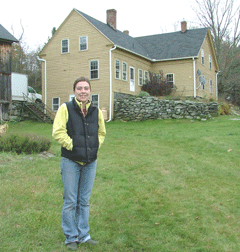
Kate Stillman is a farmer in Hardwick, Massachusetts. (Photo: Bobby Bascomb)
STILLMAN: If you look at the heritage turkeys, their heads are beautiful. These are blue slates that we’re looking at. And most of their head is this iridescent, light sky blue color with a red neck. And, I mean, the colors are fantastic, but they’re very reptile looking.
[GOBBLING]
BASCOMB: Kate and her husband Aidan raised 50 heritage turkeys this year. They also raised about 200 of the more conventional white turkeys.
STILLMAN: If you take a look at the white ones versus, you know, the colored ones are the heritage ones. And you can see there is a difference with their build and how they look.

A Blue Slate tom turkey struts his stuff. (Photo: Marc Renaghan)
[GOBBLING]
STILLMAN: The heritage ones are – well they look like they don’t have that big a breast, you know, they’re a little leaner, slimmer birds.
BASCOMB: But a trim turkey with a small breast isn’t what most people want on their Thanksgiving table.
SMITH: For whatever reason, Americans love the breast and the white meat.
BASCOMB: Andrew Smith is a turkey historian. He wrote the book on turkeys, literally. His book “Turkey: An American Tale” traces the history of our favorite fowl. The first European explorers took wild American turkeys back to Europe, where breeders started to raise them – for their feathers.
SMITH: And that’s the name of black and white and bourbon red and buff and slate, etc. The exception to that, of course, was the bronze turkey, which was the largest heritage breed, and had the largest breast.
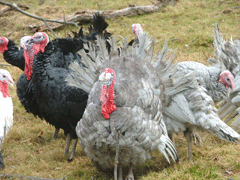
Where did its face go? Many species of heirloom turkeys have brightly colored wrinkly skin. (Photo: Marc Renaghan)
BASCOMB: That broad breasted bronze was crossed with the Holland white to create the turkey we know today – the broad breasted white. Seventy-three million of them will be eaten over the holidays. Smith says most of them are raised on factory farms.
SMITH: They’ve had their toes snipped off a few days after their birth. They’ve had their beaks snipped off in order to prevent turkeys from attacking each other, which they do in confined spaces.
BASCOMB: Milton Madison, senior agricultural economist at the USDA says most turkeys are kept in big barns. As for removing beaks and toes, he describes it as more of a turkey pedicure.
MADISON: At times, the toes and beaks will be trimmed slightly so that they’re a little more blunt, similar to trimming your finger nails so that you don’t scratch yourself or others around you.
[GOBBLING]
BASCOMB: Raising free range, heirloom turkeys is more expensive than mass producing them. They cost three times as much to buy as babies, and it takes several months longer to mature. A heritage turkey from the Stillmans will cost a hundred dollars. Compared with about sixty for the traditional birds. But people are willing to pay. Don Schrider of the American Livestock Breeds Conservancy says that’s going to help save these birds from extinction.
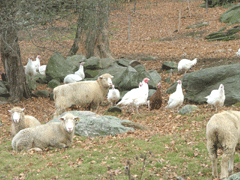
Turkey and sheep are pastured together at the Stillman turkey farm. Turkeys eat insects that would otherwise bother the sheep. (Photo: Bobby Bascomb)
SCHRIDER: If people eat heritage turkeys, then more breeding stock is maintained, and then the next season more heritage turkeys can be produced and it actually gives them a job and the population grows.
BASCOMB: The number of heirloom birds has increased eightfold in the last ten years. Farmer Kate says people like the taste of the old-fashioned birds.
[GOBBLING]
STILLMAN: The heritage birds have a higher percentage of dark meat which for dark meat lovers - and that’s usually the more flavorful part of the turkey – almost everybody who ordered a turkey from us last year has ordered two turkeys. So I don’t know whether they’re thinking they’re going to pop one in the freezer and keep it for Christmas or something like that, but people raved about the turkeys.
[GOBBLING]
BASCOMB: The demand’s been so great this year that that Stillmans actually ran out of heirloom birds.
STILLMAN: You know I had somebody call me this morning and she said to me, oh please Kate, you know, can we get a turkey from you. We’ve been away and I really wanted to call. And she’s a really good customer. We were supposed to be saving two turkeys for my aunt for Thanksgiving and I called my mother and I’m like, well, you guys are only getting one turkey ‘cause I really couldn’t say no to her. [Laughing]
BASCOMB: And so, come Thursday, the Stillmans might go without a heritage turkey at the center of their table. But they’ll have made a lot of Massachusetts families very happy.
For Living on Earth, I’m Bobby Bascomb.
Related links:
- The National Turkey Federation
- Stillman's at the Turkey Farm
- United States Department of Agriculture
- Andrew Smith’s book, The Turkey; An American Story
[MUSIC: Various Artists/Doctor Ross “Turkey Leg Mama from Thanksgiving Favorites (DMG 2006)]
GELLERMAN: Coming up – they’re enough to make you sick – so hospitals are going green. Keep listening to Living on Earth.
ANNOUNCER: Support for the Environmental Health Desk at Living on Earth comes from the Cedar Tree Foundation. Support also comes from the Richard and Rhoda Goldman fund for coverage of population and the environment. And from Gilman Ordway for coverage of conservation and environmental change. This is Living on Earth on PRI, Public Radio International.
Wal-Mart’s Wishes

Wal-Mart has a long list of green promises to live up to. (Photo: Mark Hasty)
GELLERMAN: Attention shoppers, Wal-mart, the world’s biggest retailer, has some big changes in store for it’s biggest supplier: China. Next year, Chinese companies that produce about nine billion dollars worth of goods for Wal-mart, will have to come clean, and comply with Wal-mart’s new environmental and labor requirements. Among other things it means manufacturers will have to cut energy consumption by 20 percent. The new goals were recently announced at a sustainability summit in Beijing. Andrew Winston helps companies go green - he’s founder of Winston Eco Strategies, and he attended the summit where Wal-mart explained the new policy.
WINSTON: Well right now, what they laid out in China was a set of goals and standards and very tough statements about what they would expect from their suppliers and they’ve been working on sustainability at Wal-mart for a couple years. And they’ve been working hard on supplier issues because they realized that the biggest part of their impact was not really their own operations, as big as they are, it’s what happens upstream, as they say, with all the products and where they’re made and there was only so long they could work on supply issues without going to China. China supplies, you know, 70, 80 percent of the toys in the world, a huge chunk of the apparel, etc, etc. So they had to go there and what they’ve set is very tough goals – they said you have to meet certain environmental and social standards, you have to comply with the law in China, which is not something most manufacturers do. And if you don’t, this was the big “aha” there, was if you don’t, we will drop you as a supplier. And that was what made the meeting, I thought, historic, because I’ve never seen a company do that – say outright, we will drop you and ban you, as Lee Scott said, ban you from selling products to Wal-mart.
GELLERMAN: And Lee Scott is the CEO of Wal-mart.
WINSTON: That’s right. It was an impressive performance.
GELLERMAN: But is Wal-mart willing to pay more for say, you know, a cleaning product?

Andrew Winston.
WINSTON: Well there was, you know, really a sort of fun interesting moment in this event where the CEO of FedEx was there, the CEO of Waste Management and Jeffrey Katzenberg, co-CEO of DreamWorks, the studio was there, moderating a panel on consumerism. And on the panel was the chief merchandiser for Wal-mart. And Katzenberg asked him - hey, you’ve set all these goals, will you pay an extra nickel for products, if they’re more environmentally sustainable? You know, this is a metaphorical nickel, say on a gallon of milk or whatever. And he said, we’d want to know what’s in that nickel and then we try to find ways to cut, which is the classic Wal-mart answer. And then Katzenberg wouldn’t let him get away, and he said – well, okay, but once you’ve looked at it and it just costs more to be cleaner, for the time being, are you gonna pay that nickel? And you know, the executive basically said – well, as long as we know transparently what’s in it, yes I think we would. There were sort of gasps in the room, you know, from some of the suppliers because they don’t hear that. In the past, as this executive said, we’ve asked for, you know, price cut, and we haven’t really cared, you know, how they did it. Well now we want to know what’s going into that price.
GELLERMAN: Well is the better question, you know, are Wal-mart customers – am I – willing to pay more for a more sustainable product?
WINSTON: Well, it’s certainly the critical question. I think the number of people who will pay more for green or sustainable products is still pretty small, and it’s probably going to stay small, especially now in tight times. But there’s sort of a different group of consumers, which is what some people call the conflicted consumers or conscious consumers. People who want more from their products. They think about where the product came from or how much energy it uses. And they care about those issues nearly as much as they care about the price and quality. But they want those things, I think, with no tradeoffs and that’s the big goal, I think, in sustainable products, finding ways to satisfy customers and satisfy their environmental and social needs without asking them to pay more.

Wal-Mart has a long list of green promises to live up to. (Photo: Mark Hasty)
GELLERMAN: You know, Mr. Winston, this isn’t the first time Wal-mart has promised to clean up its act. I know a number of years ago it said, “Okay, we’re going to be a hundred percent renewable energy.”
WINSTON: Right.
GELLERMAN: We’re gonna have zero waste. Those haven’t happened.
WINSTON: No, they haven’t yet. They set some, as they call them, aspirational goals. I think that’s fair. I think companies should do that. There’s lots of companies who say we’re gonna be zero waste. Very, very few have found a way to that actual goal, but it is – it’s directional. It tells people what they should be shooting for. Now, I think a company the size and recognition level of Wal-mart is only going to be given so much time to keep saying things, they’re going to have to hit some of their goals. Now on some, they have. The goals that they’ve set that are much more specific like we’re gonna reduce energy use in stores by 20 percent, or trucks – we’re gonna increase the fuel efficiency twenty, twenty-five percent. They are well on their way on some of those goals.
GELLERMAN: But isn’t there something inherently unsustainable about the Wal-mart business model. That is, you know, they ship millions of tons of stuff around the world and encourage people to buy, buy, buy, consume, consume, consume.
WINSTON: Yeah, it’s a really fascinating issue of what happens after an initial phase. Right now, what they’re asking is, you know, resource conservation fundamentally, and that saves money so that fits their business model. But what – you’re asking a pretty important question, which is what happens when you get to the point of – okay, we’ve made it very lean, but does it make sense to ship from China. Now, I’d say that part of that gets answered if we get the price of energy right. If energy prices are very high, shipping things from all over the world may turn out not to be the most economical, so some of that should work itself out through natural market forces. But there’s a fundamental mismatch in asking people to buy a lot of stuff. Wal-mart did something, I think, also more subtle but also historic in this meeting. They talked about quality a lot, which they’re not known for, you know, no one would claim they’re known for quality products. But Lee Scott said - he said almost word for word, you know, people want socks that don’t fall down after they’ve been washed. They want things that last longer. So they’re saying to their suppliers, make better products that last longer. That’s actually somewhat of a disconnect with their business model. Their model is to sell you stuff over and over again. So, I think it’s pretty profound that they’re saying - hey, higher quality products that last longer, that makes them more sustainable, that’s where the world’s going, and we’re gonna get ahead of that curve. That’s, you know, true leadership if they follow through on it.
GELLERMAN: They’re gonna start phasing in this initiative in China, starting in January ’09. And then worldwide by 2011. And I’m thinking, you know, so goes Wal-mart, so goes the world.
WINSTON: That’s right. I mean, they are that big. If they can make this happen, one of the goals they’ve set is that 95 percent of the product that they buy from Chinese suppliers will have to be from firms that are in compliance with all these audits. Now that’s a monumental number because as someone else said – one of the other speakers – something like 25 percent of the wastewater from factories in China is treated. So 75% are sort of out of compliance by definition. So getting to 95% that are in compliance is a monumental task in a country like China, and I think if we get to a point where we look back in a few years, five whatever years, and say, “Well, China’s actually a lot cleaner, so’s the world.” This will be one of those turning points.
GELLERMAN: Well, Mr. Winston, I want to thank you very much.
WINSTON: Thank you. Thanks for having me, Bruce.
GELLERMAN: Andrew Winston is the founder of Winston Eco Strategies and co-author of the book "Green to Gold".
Related links:
- Andrew Winston’s website
- For a dose of Wal-Mart’s skepticism, check out the group Wal-Mart Watch
- For more on Wal-Mart’s green ambition, click here
[MUSIC: Funkadelic “Atmosphere” from Let’s Take It To The Stage (Westbound Records 1979)]
Green Hospitals
GELLERMAN: About a dozen years ago, the U. S. Environmental Protection Agency reported that medical waste incinerators in hospitals were the largest source of deadly dioxins in the country. The disclosure shook the medical community and led to the creation of an organization that takes its name from the doctor’s Hippocratic Oath. Gary Cohen is the executive director of Health Care Without Harm.
COHEN: And we thought how ironic that is that hospitals whose mission is to heal people are contributing to environmentally related disease in this society and we said we need to redefine what that “first, do no harm” ethic means and it means clean up your act.
GELLERMAN: The hospitals quickly cleaned up their act. The number of medical waste incinerators went from 5600 to fewer than 70 still operating today and Health Care Without Harm has become a worldwide coalition of nearly 500 organizations in more than 50 countries. The mission: hospitals, heal thyself, go green. The group led the effort to safely rid medical facilities of toxic mercury found in thermometers and blood pressure devices. But Cohen says there are still things in hospitals that can make you sick:
COHEN: And in the case of patients, if you’re getting your IV drip with a PVC medical device it is dripping a reproductive toxin into your veins. Nobody’s telling you that but that’s the facts, and so our challenge to the hospitals has been look, can’t we build cancer centers without carcinogens? Can’t we build pediatric units without chemicals linked to birth defects and asthma? This is what health care needs to do. They haven’t looked at, except for the last number of years they haven’t looked at their environmental health impacts of their operations and their buildings and the stuff they buy.
GELLERMA: From bedpans and surgical gloves to operating rooms and MRI machines, hospitals are enormously expensive to build, equip and operate. And when it comes to making life saving decisions, administrators aren’t about to worry about buying energy-saving devices. Still, medicine is starting to use the power of the purse to go green. Architect Robin Guenther is co-author of the book “Sustainable Health Care Architecture.”
GUENTHER: Health care is 17 percent of the gross domestic product so health care purchasing represents a huge market leverage around any goods and services a hospital may buy.
LEVY: This is not brain surgery to save energy and water in a hospital. This is common sense kind of stuff.
GELLERMAN: Paul Levy is CEO and president of Beth Israel Deaconess Medical Center. It’s a teaching hospital - one of three in Boston’s Longwood Medical area. It has three million square feet of space, seven thousand employees, and a 1.2 billion dollar budget. Levy’s first priority is patient care; his second is green - as in money, not green as in the environment.
LEVY: Much of the energy work and environmental work in hospitals is driven more by cost issues than by a desire to make the world cleaner and reduce carbon emissions and the like, but that’s okay because they end up being the same program anyway.
GELLERMAN: Cutting costs and emissions in hospitals requires a healthy dose of technology. The prescription calls for using automated devices that control lights and temperature, the flow of air and water. Most of these devices are hidden in walls and out of sight.
[WALKING DOWN HALLWAY]
GELLERMAN: But at Beth Israel Deaconess some sensors can see you.
LEVY: It’s your traditional vending machine, it’s got a picture on the front that’s brightly light. It has a refrigerator built to keep things cool, and on top of the machine is a little sensor to keep…
GELLERMAN: Oh, look at that. I wouldn’t have noticed it…
LEVY: …to track of how many people walking by it, and when it detects that the traffic has dropped, it powers down the machine the same way your computer would go into rest mode.
[SOUND OF MAKING A PURCHASE AT A VENDING MACHINE]
GELLERMAN: Vending machines are energy vampires, so hospital utility manager Mark Lukitsch has installed automatic detection devices to curb their appetite. He says small change can add up.
LUKITSCH: We’re able to save probably, with the 26 units we installed over the next 10 years, somewhere in the 70, 000 dollar range, just for a simple device that has a payback of less than a year.
GELLERMAN: Again, hospital CEO Paul Levy.
LEVY: The thing is about hospital buildings, because they’re so big, and because they’re so energy intensive, you can make a minor modification in the operation of building and actually result in a fairly substantial savings.
[WALKING DOWN HALLWAY]
GELLERMAN: Down the street from Boston’s Beth Israel is Brigham and Women’s Hospital. It has nearly twice as many employees, 13,000.
MOMBOURQUETTE: It’s a big business, it’s a big business. About 9,000 babies are born here every year. It’s the biggest in New England, and one of the biggest in the country actually.
GELLERMAN: Art Mombourquette is vice president of support services at Brigham and Woman’s. The hospital is a city unto itself. A hallway a quarter of a mile long - called the pike - connects buildings.
MOMBOURQUETTE: We’re walking on one of our green initiatives – this corridor is in the process of being replaced. It’s an old vinyl composition tile that we’re ripping out and replacing it with a renewable product, it’s a rubber product. Not only is it a renewable product, it also doesn’t require any floor finishes, which means it doesn’t need any harsh chemicals to clean it off when it yellows. So it’s much better for the people who need to clean it. It’s also softer, to walk on, it’s a nice product.
GELLERMAN: It’s quiet.
MOMBOURQUETTE: It’s very quiet.
GELLERMAN: The long hallway leads to Brigham’s newest building, the Shapiro Cardiovascular Center, 300,000 square feet of highly specialized space. It’s certified silver LEED – it was designed green from the get go. No new parking spaces were added. Instead, employees were given mass transit passes. Houses that once stood on the property were moved - recycled, in a sense - to preserve the community. And inside the building’s soaring atrium, special glazing was used on glass to reduce heating and cooling needs. And every patient’s room has floor-to-ceiling windows.
MOMBOURQUETTE: The patient rooms actually slope up at the window, so literally funneling light into the room.
GELLERMAN: This is a hospital. Can the things that you’ve changed, letting in more light, using environmentally sound cleaning materials, can that help save people’s lives or improve their health?
MOMBOURQUETTE: I think there’s beginning to be evidence that that’s a true statement, and so while it’s a little difficult to quantify, there is beginning to be evidence that natural light helps healing.
GELLERMAN: Studies show hospital patients with an outside view suffer fewer complications, need less pain medication and are discharged sooner. Similar benefits have been found in hospitals where family members can stay overnight. And many hospitals are starting to build green roofs to bring nature closer to patients. And they’re improving the food they serve, buying organic and locally grown.
It’s all part of what’s called “evidence based design.” It’s a concept that architect Robin Guenther says expands the definition of what constitutes health care.
GUENTHER: Buildings ultimately are the clothing that we put on our institutions. Buildings embody all our values, so when you inhabit a green building, it changes how you think about who you are and what you’re doing.
GELLERMAN: At Boston’s Beth Israel Deaconess, changes in architecture are changing attitudes. Community director Jane Matlaw founded “Healthy Work/Healthy Home,” a program encouraging employees to bring new green ideas to the hospital.
MATLAW: And now I have people calling me frequently, saying, “Why aren’t we doing this? Could we be doing this? How do we do that? and How do we make it better?” So, it’s really gone from, you’re a lunatic out there doing your thing, to something people really have embraced.
GELLERMAN: The benefits from going green, says Bill Ravanesi, Boston Director of Health Care Without Harm will pay for themselves - in more ways than money.
RAVANESI: There’s a big transformation. We have a green tsunami around us right now, and what we’re seeing is a transformation in thinking in health care, going from a mindset that says “let’s build an institution,” into a different kind of vision, and this vision is a healing environment.
GELLERMAN: The green wave has gone mainstream - and hospitals, their workers, their patients, and communities are the better for it.
Our story about green hospitals was reported with the help of Annie Jia.
[MUSIC: Thelonious Monk “Green Chimney’s” from Underground (Columbia Records 1969)]
On the next Living on Earth: They may be extinct – but dinosaurs are making a come-back, in the toy store.
CHILD: Once she snuggled up with one of my stuffed animals and then fell asleep with it, and then one other time when she was in my room, she stood on two legs and said Ta-da.
GELLERMAN: Robosaurs come alive, next time on Living on Earth.
[SOUND OF CROWS]
GELLERMAN: We leave you this week in a cold woodland at dusk, with a murder.
[SOUND OF CROWS]
GELLERMAN: A murder of crows that is - five carrion crows calling through the blustery winds in Woodchester Park in Gloucestershire, England. Richard Margoschis recorded the scene of the murder, for The British Library National Sound Archive. It’s on the CD “Wild Britain.”
[SOUND OF CROWS AND WIND]
Living on Earth is produced by the World Media Foundation. Our crew includes Ashley Ahearn, Bobby Bascomb, Eileen Bolinsky, Ingrid Lobet, Helen Palmer, Mitra Taj and Jeff Young, with help from Sarah Calkins and Marilyn Govoni. Our interns are Sandra Larson and Jessie Martin. Jeff Turton is our technical director. Alison Lirish Dean composed our themes. You can find us at loe.org. Our executive producer is Steve Curwood. I’m Bruce Gellerman. Thanks for listening.
ANNOUNCER: Funding for Living on Earth comes from the National Science Foundation, supporting coverage of emerging science, and Stonyfield Farm: organic yogurt and smoothies. Stonyfield pays its farmers not to use artificial growth hormones on their cows. Details at stonyfield.com.
Support also comes from you our listeners, the Ford Foundation, the Town Creek Foundation, the Oak Foundation, supporting coverage of climate change and marine issues; The Bill and Melinda Gates Foundation, dedicated to the idea that all people deserve the chance to live a healthy productive life. Information at gatesfoundation.org; and Pax World Mutual Funds: socially and environmentally sustainable investing. Pax World: for tomorrow. On the web at paxworld.com.
ANNOUNCER: PRI, Public Radio International.
Living on Earth wants to hear from you!
Living on Earth
62 Calef Highway, Suite 212
Lee, NH 03861
Telephone: 617-287-4121
E-mail: comments@loe.org
Newsletter [Click here]
Donate to Living on Earth!
Living on Earth is an independent media program and relies entirely on contributions from listeners and institutions supporting public service. Please donate now to preserve an independent environmental voice.
NewsletterLiving on Earth offers a weekly delivery of the show's rundown to your mailbox. Sign up for our newsletter today!
 Sailors For The Sea: Be the change you want to sea.
Sailors For The Sea: Be the change you want to sea.
 The Grantham Foundation for the Protection of the Environment: Committed to protecting and improving the health of the global environment.
The Grantham Foundation for the Protection of the Environment: Committed to protecting and improving the health of the global environment.
 Contribute to Living on Earth and receive, as our gift to you, an archival print of one of Mark Seth Lender's extraordinary wildlife photographs. Follow the link to see Mark's current collection of photographs.
Contribute to Living on Earth and receive, as our gift to you, an archival print of one of Mark Seth Lender's extraordinary wildlife photographs. Follow the link to see Mark's current collection of photographs.
 Buy a signed copy of Mark Seth Lender's book Smeagull the Seagull & support Living on Earth
Buy a signed copy of Mark Seth Lender's book Smeagull the Seagull & support Living on Earth

